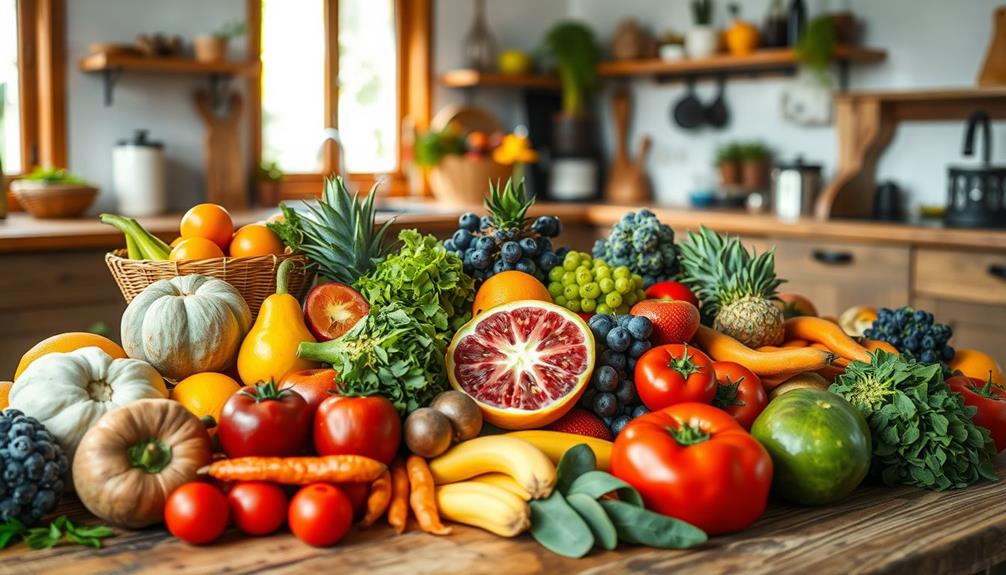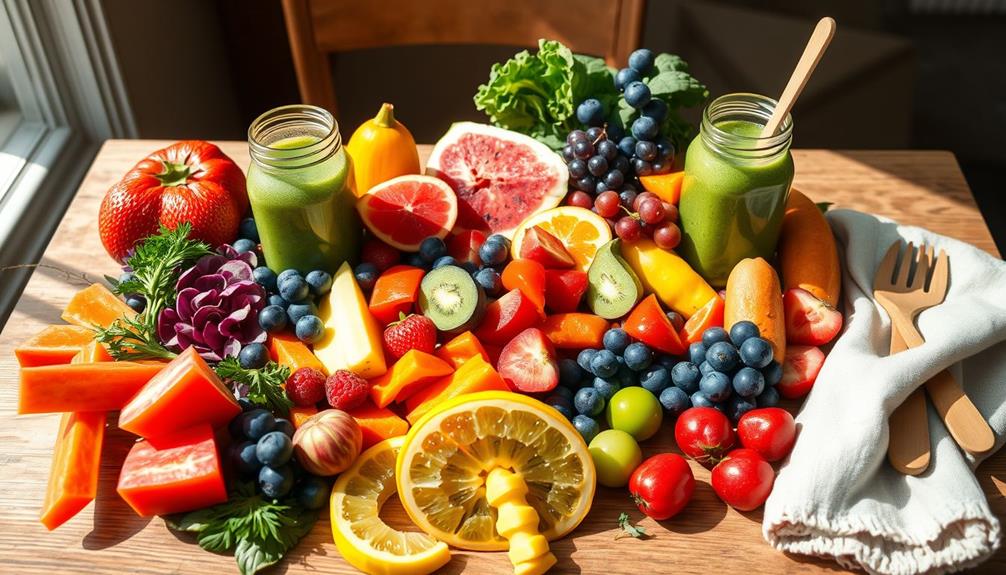The raw food diet emphasizes uncooked and unprocessed foods, which can make it seem trendy. However, its restrictive nature raises concerns about nutrient deficiencies, like vitamin B12, affecting 38% of followers. While proponents claim benefits such as increased energy and weight loss, experts warn about potential long-term health risks, including osteoporosis. Compared to other diets, the raw food approach lacks balance and can lead to significant deficiencies. It's worth considering the practical implications and nutritional gaps before committing. There's much more to explore regarding this dietary trend and its impact on your health.
Key Takeaways
- The raw food diet emphasizes uncooked, unprocessed foods, aligning with current health trends but often lacks scientific support for its health claims.
- Advocates promote benefits like increased energy and weight loss, yet these claims are often anecdotal and not universally supported by research.
- Nutritional deficiencies, particularly in vitamins B12 and omega-3 fatty acids, raise concerns about the diet's long-term sustainability and health impact.
- The restrictive nature of the raw food diet shares similarities with other fad diets, which often lead to significant nutrient gaps.
- Experts recommend a balanced approach to nutrition, suggesting that incorporating a variety of food groups is essential for overall health.
Overview of the Raw Food Diet
The raw food diet, a lifestyle choice that gained traction in the mid-1970s, emphasizes consuming uncooked and unprocessed foods. You'll mainly focus on fruits, vegetables, nuts, seeds, and sprouted grains, preparing them through methods like blending, juicing, and soaking without exceeding 118°F.
Advocates believe that eating raw foods enhances energy, promotes weight loss, and improves overall health by preserving the natural enzymes and nutrients that cooking often destroys. Additionally, incorporating nutrient-rich foods into your diet can help mitigate some of the deficiencies associated with strict dietary restrictions.
However, it's crucial to recognize potential drawbacks. The restrictive nature of the raw food diet can lead to nutritional deficiencies, particularly in vitamin B12 and omega-3 fatty acids. These deficiencies can pose serious health risks, including compromised bone health, as some raw-foodists show lower bone density.
Variants of this diet, such as raw vegan, raw vegetarian, and raw omnivorous diets, offer different approaches but can still share these nutritional concerns.
While the raw food diet might appeal to you for its perceived health benefits, consider the sustainability of such a restrictive lifestyle. Balancing raw foods with other food groups may provide a more thorough approach to nutrition.
Scientific Evidence and Findings

Numerous studies have explored the health claims associated with the raw food diet, but the scientific evidence remains limited and often contradictory. While some research suggests potential benefits, such as lower LDL cholesterol levels in raw-foodists, other findings raise concerns about nutritional deficiencies and health risks.
Additionally, it's important to take into account the role of a balanced diet in maintaining overall health, as seen in various dietary recommendations like the gout nutrition guide.
Consider these points:
- Enzyme Hypothesis: Proponents claim that raw foods are rich in enzymes, but there's scant scientific backing for this idea.
- Nutritional Deficiencies: A significant percentage of raw-food dieters—38%—are found to be deficient in vitamin B12, essential for heart health.
- Bone Health Risks: While raw-food followers may have lower body mass indices, they often exhibit lower bone densities, increasing their risk for osteoporosis.
Expert Opinions on the Diet

How do experts view the raw food diet? Many health professionals express concerns about its restrictive nature. While raw diets emphasize uncooked foods, experts highlight potential nutrient deficiencies, particularly in vitamin B12 and omega-3 fatty acids.
Nutritionists point out that strict adherence may lack the balance necessary for long-term health, potentially leading to problems like osteoporosis due to lower bone density. Additionally, some practitioners suggest incorporating essential oils, such as eucalyptus oil for its decongestant benefits, to support overall wellness alongside dietary choices.
Some studies suggest that those on raw food diets experience lower LDL cholesterol levels and body mass indices, but experts warn that these benefits come with trade-offs. Cooking can enhance the bioavailability of certain nutrients, such as lycopene in tomatoes, meaning that a completely raw approach may not optimize nutrient absorption.
Health Benefits and Risks

Many people find that adopting a raw food diet offers both impressive health benefits and notable risks. On one hand, raw eating can lead to increased intake of essential vitamins and minerals, which may promote weight loss and boost your energy levels.
The potential health benefits include:
- Lower LDL cholesterol levels, improving heart health.
- Reduced body mass indices, aiding in weight management.
- Higher consumption of fruits and vegetables, enhancing overall nutrition.
In addition, following a budget can be beneficial for managing any dietary expenses, allowing for better allocation of resources for high-quality raw food options, especially when considering creating a personal budget.
However, it's important to be aware of the associated risks. The restrictive nature of the raw food diet can lead to deficiencies in essential nutrients like omega-3 fatty acids and protein.
Additionally, while you might experience weight loss, you could also face lower bone density, increasing your risk for osteoporosis.
Moreover, raw foods can elevate the risk of foodborne illnesses and gastrointestinal issues, especially when consuming raw animal products.
Nutritional Concerns and Deficiencies

You might find that the raw food diet leads to significant nutrient deficiencies, especially in vitamins and minerals commonly found in animal products.
This is particularly concerning since a raw food diet can enhance nutrient absorption due to minimal processing, but without careful planning, you could risk long-term health issues, such as muscle loss and heart problems.
Understanding these nutritional gaps is essential if you're considering this lifestyle, particularly since it's recommended to consult with a veterinarian for balanced nutrition when it comes to pets on a raw food diet consulting a veterinarian.
Key Nutrient Deficiencies
The raw food diet's allure can overshadow its potential nutritional pitfalls, leading many to unknowingly face key nutrient deficiencies.
While embracing raw foods might seem healthy, it can come with significant health risks, similar to the importance of discussing personal risk factors with healthcare providers when it comes to breast health.
mammography aims to detect breast cancer early for better treatment outcomes.
Here are three essential nutrients you might be lacking:
- Vitamin B12: A staggering 38% of raw-food dieters are deficient in this crucial nutrient, vital for heart health and found mainly in animal products.
- Omega-3 Fatty Acids: These essential fats, critical for brain function, are often missing from a raw food diet since they primarily come from fish, flaxseeds, and walnuts.
- Calcium and Protein: The restrictive nature of the raw food diet can lead to inadequate calcium intake, raising concerns about bone density and increasing the risk of osteoporosis.
Moreover, cooking can enhance the bioavailability of certain nutrients, like lycopene in tomatoes, meaning you might miss out on important health benefits while following a strictly raw diet.
Be aware of these deficiencies and consider how they might impact your overall health before fully committing to the raw food lifestyle.
Long-term Health Risks
Steering through the long-term health risks associated with a raw food diet can be challenging, especially when considering the potential for considerable nutritional concerns. One major issue is nutrient deficiencies; many followers struggle to get enough essential vitamins and minerals. For instance, about 38% of raw foodists are deficient in vitamin B12, essential for heart health.
Additionally, incorporating a balanced diet, as recommended in effective strategies for weight loss, can greatly help in mitigating these deficiencies.
Moreover, the restrictive nature of the raw food diet can lead to inadequate intake of omega-3 fatty acids, calcium, vitamin D, and iron, all fundamental for overall well-being. This deficiency can result in lower bone density, increasing the risk for osteoporosis, as studies indicate that raw foodists often have a lower body mass index along with reduced bone density.
Furthermore, cooking improves the bioavailability of certain nutrients, such as lycopene in tomatoes. By strictly adhering to a raw food consumption plan, you might miss out on these health benefits.
Given the elimination of whole food groups, the raw food diet may not provide thorough nutrition, making it unsuitable as a long-term dietary plan. Recognizing these long-term health risks is essential for anyone considering this lifestyle.
Comparison With Other Dietary Trends

When you compare the raw food diet to other dietary trends, you'll notice similar concerns about nutritional adequacy.
Just like restrictive diets such as veganism or extreme low-carb plans, the raw food diet can lead to significant nutrient deficiencies.
Additionally, some individuals may experience emotional dysregulation, akin to challenges seen in those with Borderline Personality Disorder (BPD), which can further complicate their relationship with food.
It's important to weigh the health risks associated with these diets to understand their long-term impacts on your well-being.
Nutritional Adequacy Concerns
Addressing nutritional adequacy concerns, the raw food diet faces scrutiny for its restrictive nature, which can lead to significant deficiencies in important nutrients.
While it's packed with fruits and vegetables, you may find yourself lacking fundamental components that other balanced diets offer. Additionally, investing in a diversified portfolio could help mitigate some of the financial risks associated with diet choices, much like how Gold IRAs offer potential for long-term capital appreciation.
Here are three key nutritional gaps to reflect on:
- Vitamin B12: A study revealed that 38% of raw-foodists are deficient in this important nutrient, essential for heart health and neurological function.
- Omega-3 Fatty Acids: The absence of cooked foods in a raw diet limits your intake of omega-3 sources like fish, which are crucial for brain health.
- Calcium and Vitamin D: The lack of fortified foods can compromise your bone health, leading to increased osteoporosis risks.
In comparison to other dietary trends, such as the Mediterranean diet, the raw food diet may fall short in overall nutritional adequacy.
Cooking enhances the bioavailability of certain nutrients, such as lycopene in tomatoes. Consequently, while the raw food diet has its appeal, it's important to evaluate the potential health risks associated with its restrictive approach to nutrition.
Health Risks Comparison
The raw food diet's restrictive nature brings health risks that are worth comparing to other popular dietary trends. Like the raw food approach, diets such as Atkins and ketogenic also limit food choices, potentially leading to nutrient deficiencies, including vitamin B12 and omega-3s.
This restriction can affect not only physical health but also emotional and psychological growth, as key domains of development indicate that a balanced diet is essential for overall well-being. While followers of the raw food diet may enjoy lower LDL cholesterol levels, they also risk lower bone density—an issue that can arise in other restrictive diets too.
Eating uncooked meat and raw animal products in the raw food diet raises concerns about foodborne illnesses, similar to the risks associated with low-carbohydrate diets. Both dietary trends can expose you to harmful bacteria due to insufficient cooking.
Furthermore, the raw food diet aligns with the Paleolithic diet's philosophy of ancestral eating but faces criticism for its sustainability and health risks.
Practical Considerations for Adopting the Diet

Adopting a raw food diet demands thoughtful meal planning to guarantee you're getting balanced nutrition. The restrictive nature of the diet can lead to deficiencies in essential nutrients, so it's vital to be mindful of your choices.
Here are three practical considerations to keep in mind:
- Meal Prep: Dedicate time to prepare meals using methods like blending, soaking, and sprouting. This variety helps maintain nutritional adequacy and keeps meals exciting.
- Dining Options: When eating out or traveling, you might find limited options. Be proactive in planning meals and sourcing ingredients to avoid relying on processed foods that can compromise food safety and your dietary goals.
- Consult Professionals: Before diving in, consult a registered dietitian. They can help you navigate potential gaps, particularly in nutrients like vitamin B12 and calcium, which may be lacking in a raw food diet.
They can also provide insights on how to manage chronic diseases while following this eating style.
Frequently Asked Questions
Is the Raw Food Diet a Fad Diet?
You might find the raw food diet appealing, but it's often viewed as a fad. While it promises benefits, it can lead to nutrient deficiencies and long-term health risks that outweigh short-term gains.
What Is the Raw Food Trend?
Did you know that 30% of raw food dieters report increased energy levels? The raw food trend focuses on unprocessed foods, promoting fruits, veggies, nuts, and seeds for their perceived health benefits and nutrient retention.
What Is the Fad of Food Diet?
A fad food diet promises quick weight loss and health improvements but often lacks scientific support. You might find it appealing, yet these diets can lead to nutritional imbalances and are usually unsustainable long-term.
Why Has the Raw Food Diet Become Popular?
The raw food diet's popularity stems from its promise of increased energy, weight loss, and disease prevention. Influencers and social media have sparked interest, making it appealing to those seeking healthier, unprocessed food choices.
Conclusion
To sum up, while the raw food diet might seem like a trendy flash in the pan, it offers both benefits and challenges. You've got to weigh the potential health perks against the risks and nutritional gaps. If you're considering diving into this lifestyle, just remember: balance is key. Like a vintage vinyl record, it's all about finding the right groove. So, whether you go raw or not, listen to your body and choose what works best for you.










